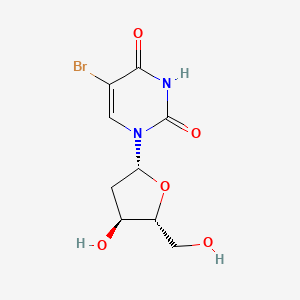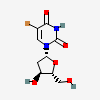5-Bromo-2'-deoxyuridine
- 5-BROMO-2'-DEOXYURIDINE
- 59-14-3
- Broxuridine
- Bromodeoxyuridine
- 5-Bromodeoxyuridine
- Create:2005-06-24
- Modify:2025-01-11

- 5 Bromo 2' deoxyuridine
- 5 Bromodeoxyuridine
- 5-Bromo-2'-deoxyuridine
- 5-Bromodeoxyuridine
- BrdU
- Bromodeoxyuridine
- Bromouracil Deoxyriboside
- Broxuridine
- BUdR
- Deoxyriboside, Bromouracil
- NSC-38297
- 5-BROMO-2'-DEOXYURIDINE
- 59-14-3
- Broxuridine
- Bromodeoxyuridine
- 5-Bromodeoxyuridine
- 5-BrdU
- BRDU
- BUDR
- 5-Bromouracil deoxyriboside
- Bromouracil deoxyriboside
- 5-Bromo-2-deoxyuridine
- 5-Bromodesoxyuridine
- 5-Bdu
- Broxuridinum
- Broxuridina
- 5-Bromouracil-2-deoxyriboside
- C9H11BrN2O5
- Uridine, 5-bromo-2'-deoxy-
- NSC-38297
- MFCD00006529
- CHEBI:472552
- 5-bromo-1-((2R,4S,5R)-4-hydroxy-5-(hydroxymethyl)tetrahydrofuran-2-yl)pyrimidine-2,4(1H,3H)-dione
- 5-bromo-2'-deoxy uridine
- CHEMBL222280
- DTXSID7033105
- 5-Bromo-1-(2-deoxy-beta-D-ribofuranosyl)uracil
- G34N38R2N1
- 5-Bromo-2'-deoxyuridine (BRDU)
- 5-Bromo-1-[(2R,4S,5R)-4-hydroxy-5-(hydroxymethyl)oxolan-2-yl]pyrimidine-2,4-dione
- NCGC00090770-05
- Broxuridine [INN]
- DTXCID5013105
- Broxuridinum [INN-Latin]
- BDU
- Broxuridina [INN-Spanish]
- CAS-59-14-3
- SMR001227189
- CCRIS 818
- HSDB 7477
- Broxuridine [INN:JAN]
- EINECS 200-415-9
- (+)-5-Bromo-2'-deoxyuridine
- BRN 0030395
- UNII-G34N38R2N1
- 5-Bromo-2'-deoxyuridine(BRDU)
- 5-bromo-1-[(2R,4S,5R)-4-hydroxy-5-(hydroxymethyl)tetrahydrofuran-2-yl]pyrimidine-2,4-dione
- 5-Bromo-dURD
- 5-brom-2'-desoxyuridin
- Broxuridine (JAN/INN)
- BROXURIDINE [MI]
- Maybridge4_003385
- BROXURIDINE [JAN]
- BROXURIDINE [HSDB]
- Epitope ID:138105
- cid_6035
- BROXURIDINE [MART.]
- 5-Bromo-2 inverted exclamation marka-deoxyuridine
- Lopac0_000212
- SCHEMBL27755
- BROXURIDINE [WHO-DD]
- 4-24-00-01234 (Beilstein Handbook Reference)
- MLS001055406
- MLS002153366
- 5-Bromo-2'-deoxyuridine, 97%
- HMS1619B05
- HMS3039G15
- HMS3260L05
- BCP21681
- 5-BROMO-2''-DEOXY URIDINE
- Tox21_111016
- Tox21_200106
- Tox21_500212
- BDBM50207303
- HB0979
- HG1160
- STL530083
- AKOS001715166
- AKOS016015753
- AKOS037495737
- Tox21_111016_1
- CCG-204307
- DB12028
- LP00212
- SDCCGSBI-0050200.P002
- BrdU (5-Bromo-2′-deoxyuridine)
- NCGC00090770-01
- NCGC00090770-02
- NCGC00090770-03
- NCGC00090770-04
- NCGC00090770-06
- NCGC00090770-07
- NCGC00090770-08
- NCGC00090770-09
- NCGC00090770-14
- NCGC00175901-01
- NCGC00257660-01
- NCGC00260897-01
- 1-[(4S,2R,5R)-4-hydroxy-5-(hydroxymethyl)oxolan-2-yl]-5-bromo-1,3-dihydropyrim idine-2,4-dione
- 5-bromo-1-[(2R,4S,5R)-4-hydroxy-5-(hydroxymethyl)oxolan-2-yl]-1,2,3,4-tetrahydropyrimidine-2,4-dione
- AS-11762
- BP-58665
- HY-15910
- 5-Bromo-2'-deoxyuridine, >=99% (HPLC)
- B1575
- EU-0100212
- NS00034095
- 5-Bromo-2'-deoxyuridine, BioUltra, >=99%
- 5-Bromo-2'-deoxyuridine, >=99.0% (HPLC)
- B 5002
- D01763
- EN300-7376709
- Q419861
- SR-01000075718
- J-700086
- SR-01000075718-1
- BRD-K79095980-001-09-6
- Br-dU; 5-Bromo-1-(2-deoxy-beta-D-ribofuranosyl)uracil
- Carbobenzoxy-valyl-alanyl-aspartyl-[O-methyl]-fluoromethylketone
- (+)-5-bromo-1-[(2R,4S,5R)-4-hydroxy-5-(hydroxymethyl)oxolan-2-yl]- pyrimidine-2,4-dione
- 5-bromo-1-(2-deoxy-beta-D-erythro-pentofuranosyl)-4-hydroxypyrimidin-2(1H)-one
- 5-bromo-1-((2R,4S,5R)-4-hydroxy-5-(hydroxymethyl)-tetrahydrofuran-2-yl)pyridine-2,4(1H,3H)-dione
- 5-bromo-1-((2R,4S,5R)-4-hydroxy-5-(hydroxymethyl)-tetrahydrofuran-2-yl)pyrimidine-2,4(1H,3H)-dione

H340 (83.3%): May cause genetic defects [Danger Germ cell mutagenicity]
H341 (13%): Suspected of causing genetic defects [Warning Germ cell mutagenicity]
H361 (79.6%): Suspected of damaging fertility or the unborn child [Warning Reproductive toxicity]
P203, P280, P318, P405, and P501
(The corresponding statement to each P-code can be found at the GHS Classification page.)
Aggregated GHS information provided per 54 reports by companies from 10 notifications to the ECHA C&L Inventory. Each notification may be associated with multiple companies.
Information may vary between notifications depending on impurities, additives, and other factors. The percentage value in parenthesis indicates the notified classification ratio from companies that provide hazard codes. Only hazard codes with percentage values above 10% are shown.
Muta. 1B (83.3%)
Muta. 2 (13%)
Repr. 2 (79.6%)
EYES: First check the victim for contact lenses and remove if present. Flush victim's eyes with water or normal saline solution for 20 to 30 minutes while simultaneously calling a hospital or poison control center. Do not put any ointments, oils, or medication in the victim's eyes without specific instructions from a physician. IMMEDIATELY transport the victim after flushing eyes to a hospital even if no symptoms (such as redness or irritation) develop.
SKIN: IMMEDIATELY flood affected skin with water while removing and isolating all contaminated clothing. Gently wash all affected skin areas thoroughly with soap and water. If symptoms such as redness or irritation develop, IMMEDIATELY call a physician and be prepared to transport the victim to a hospital for treatment.
INHALATION: IMMEDIATELY leave the contaminated area; take deep breaths of fresh air. If symptoms (such as wheezing, coughing, shortness of breath, or burning in the mouth, throat, or chest) develop, call a physician and be prepared to transport the victim to a hospital. Provide proper respiratory protection to rescuers entering an unknown atmosphere. Whenever possible, Self-Contained Breathing Apparatus (SCBA) should be used; if not available, use a level of protection greater than or equal to that advised under Protective Clothing.
INGESTION: DO NOT INDUCE VOMITING. If the victim is conscious and not convulsing, give 1 or 2 glasses of water to dilute the chemical and IMMEDIATELY call a hospital or poison control center. Be prepared to transport the victim to a hospital if advised by a physician. If the victim is convulsing or unconscious, do not give anything by mouth, ensure that the victim's airway is open and lay the victim on his/her side with the head lower than the body. DO NOT INDUCE VOMITING. IMMEDIATELY transport the victim to a hospital. (NTP, 1992)
SMALL SPILLS AND LEAKAGE: If you spill this chemical, you should dampen the solid spill material with water, then transfer the dampened material to a suitable container. Use absorbent paper dampened with water to pick up any remaining material. Seal your contaminated clothing and the absorbent paper in a vapor-tight plastic bag for eventual disposal. Wash all contaminated surfaces with a soap and water solution. Do not reenter the contaminated area until the Safety Officer (or other responsible person) has verified that the area has been properly cleaned.
STORAGE PRECAUTIONS: You should protect this chemical from exposure to light, and store it in a freezer. (NTP, 1992)
Alcohols and Polyols
Amides and Imides
Amines, Phosphines, and Pyridines
Halogenated Organic Compounds
Patents are available for this chemical structure:
https://patentscope.wipo.int/search/en/result.jsf?inchikey=WOVKYSAHUYNSMH-RRKCRQDMSA-N
- CAMEO ChemicalsLICENSECAMEO Chemicals and all other CAMEO products are available at no charge to those organizations and individuals (recipients) responsible for the safe handling of chemicals. However, some of the chemical data itself is subject to the copyright restrictions of the companies or organizations that provided the data.https://cameochemicals.noaa.gov/help/reference/terms_and_conditions.htm?d_f=false5-BROMO-2'-DEOXYURIDINEhttps://cameochemicals.noaa.gov/chemical/19900CAMEO Chemical Reactivity Classificationhttps://cameochemicals.noaa.gov/browse/react
- CAS Common ChemistryLICENSEThe data from CAS Common Chemistry is provided under a CC-BY-NC 4.0 license, unless otherwise stated.https://creativecommons.org/licenses/by-nc/4.0/5-Bromo-2′-deoxyuridinehttps://commonchemistry.cas.org/detail?cas_rn=59-14-3
- ChemIDplusBroxuridine [INN:JAN]https://pubchem.ncbi.nlm.nih.gov/substance/?source=chemidplus&sourceid=0000059143ChemIDplus Chemical Information Classificationhttps://pubchem.ncbi.nlm.nih.gov/source/ChemIDplus
- DrugBankLICENSECreative Common's Attribution-NonCommercial 4.0 International License (http://creativecommons.org/licenses/by-nc/4.0/legalcode)https://www.drugbank.ca/legal/terms_of_useBroxuridinehttps://www.drugbank.ca/drugs/DB12028
- EPA Chemicals under the TSCAUridine, 5-bromo-2'-deoxy-https://www.epa.gov/chemicals-under-tscaEPA TSCA Classificationhttps://www.epa.gov/tsca-inventory
- EPA DSSTox5-Bromo-2'-deoxyuridinehttps://comptox.epa.gov/dashboard/DTXSID7033105CompTox Chemicals Dashboard Chemical Listshttps://comptox.epa.gov/dashboard/chemical-lists/
- European Chemicals Agency (ECHA)LICENSEUse of the information, documents and data from the ECHA website is subject to the terms and conditions of this Legal Notice, and subject to other binding limitations provided for under applicable law, the information, documents and data made available on the ECHA website may be reproduced, distributed and/or used, totally or in part, for non-commercial purposes provided that ECHA is acknowledged as the source: "Source: European Chemicals Agency, http://echa.europa.eu/". Such acknowledgement must be included in each copy of the material. ECHA permits and encourages organisations and individuals to create links to the ECHA website under the following cumulative conditions: Links can only be made to webpages that provide a link to the Legal Notice page.https://echa.europa.eu/web/guest/legal-noticeBroxuridine (EC: 200-415-9)https://echa.europa.eu/information-on-chemicals/cl-inventory-database/-/discli/details/51329
- FDA Global Substance Registration System (GSRS)LICENSEUnless otherwise noted, the contents of the FDA website (www.fda.gov), both text and graphics, are not copyrighted. They are in the public domain and may be republished, reprinted and otherwise used freely by anyone without the need to obtain permission from FDA. Credit to the U.S. Food and Drug Administration as the source is appreciated but not required.https://www.fda.gov/about-fda/about-website/website-policies#linking
- Hazardous Substances Data Bank (HSDB)BROMODEOXYURIDINEhttps://pubchem.ncbi.nlm.nih.gov/source/hsdb/7477
- ChEBI5-bromo-2'-deoxyuridinehttps://www.ebi.ac.uk/chebi/searchId.do?chebiId=CHEBI:472552
- NCI Thesaurus (NCIt)LICENSEUnless otherwise indicated, all text within NCI products is free of copyright and may be reused without our permission. Credit the National Cancer Institute as the source.https://www.cancer.gov/policies/copyright-reuseNCI Thesaurushttps://ncit.nci.nih.gov
- Open TargetsLICENSEDatasets generated by the Open Targets Platform are freely available for download.https://platform-docs.opentargets.org/licence
- Toxin and Toxin Target Database (T3DB)LICENSET3DB is offered to the public as a freely available resource. Use and re-distribution of the data, in whole or in part, for commercial purposes requires explicit permission of the authors and explicit acknowledgment of the source material (T3DB) and the original publication.http://www.t3db.ca/downloadsBromodeoxyuridinehttp://www.t3db.ca/toxins/T3D1782
- NCI Investigational Drugs
- ChEMBLLICENSEAccess to the web interface of ChEMBL is made under the EBI's Terms of Use (http://www.ebi.ac.uk/Information/termsofuse.html). The ChEMBL data is made available on a Creative Commons Attribution-Share Alike 3.0 Unported License (http://creativecommons.org/licenses/by-sa/3.0/).http://www.ebi.ac.uk/Information/termsofuse.htmlChEMBL Protein Target Treehttps://www.ebi.ac.uk/chembl/g/#browse/targets
- ClinicalTrials.govLICENSEThe ClinicalTrials.gov data carry an international copyright outside the United States and its Territories or Possessions. Some ClinicalTrials.gov data may be subject to the copyright of third parties; you should consult these entities for any additional terms of use.https://clinicaltrials.gov/ct2/about-site/terms-conditions#Use
- Comparative Toxicogenomics Database (CTD)LICENSEIt is to be used only for research and educational purposes. Any reproduction or use for commercial purpose is prohibited without the prior express written permission of NC State University.http://ctdbase.org/about/legal.jspBromodeoxyuridinehttps://ctdbase.org/detail.go?type=chem&acc=D001973
- Drug Gene Interaction database (DGIdb)LICENSEThe data used in DGIdb is all open access and where possible made available as raw data dumps in the downloads section.http://www.dgidb.org/downloadsBROXURIDINEhttps://www.dgidb.org/drugs/ncit:C318
- Therapeutic Target Database (TTD)BROMODEOXYURIDINEhttps://idrblab.net/ttd/data/drug/details/D0M4MA
- Crystallography Open Database (COD)LICENSEAll data in the COD and the database itself are dedicated to the public domain and licensed under the CC0 License. Users of the data should acknowledge the original authors of the structural data.https://creativecommons.org/publicdomain/zero/1.0/
- The Cambridge Structural Database
- IUPAC Digitized pKa Dataseturidine, 5-bromo-2'-deoxy-https://github.com/IUPAC/Dissociation-Constants
- Japan Chemical Substance Dictionary (Nikkaji)
- KEGGLICENSEAcademic users may freely use the KEGG website. Non-academic use of KEGG generally requires a commercial licensehttps://www.kegg.jp/kegg/legal.html
- Metabolomics Workbench5-bromo-2'-deoxyuridinehttps://www.metabolomicsworkbench.org/data/StructureData.php?RegNo=52757
- Nature Chemical Biology
- NORMAN Suspect List ExchangeLICENSEData: CC-BY 4.0; Code (hosted by ECI, LCSB): Artistic-2.0https://creativecommons.org/licenses/by/4.0/5-Bromo-2'-deoxyuridineNORMAN Suspect List Exchange Classificationhttps://www.norman-network.com/nds/SLE/
- Protein Data Bank in Europe (PDBe)
- SpectraBase5-BROMO-2'-DEOXYURIDINEhttps://spectrabase.com/spectrum/FajRRLhREco5-bromo-2'-deoxyuridinehttps://spectrabase.com/spectrum/J3YFFJKgsBP5-BROMO-2'-DEOXY-URIDINEhttps://spectrabase.com/spectrum/KsC7NRu2A6i5-BROMO-2'-DEOXYURIDINEhttps://spectrabase.com/spectrum/HRiFAv7cYx35-Bromo-2'-deoxyuridinehttps://spectrabase.com/spectrum/KkN5QoLuwx5-Bromo-2'-deoxyuridinehttps://spectrabase.com/spectrum/6HiIPbLIrFB
- Springer Nature
- SpringerMaterials5-Brom-2'-desoxyuridinhttps://materials.springer.com/substanceprofile/docs/smsid_lxmujjhhycltpxnm
- Wikidatabromodeoxyuridinehttps://www.wikidata.org/wiki/Q419861
- WikipediaBromodeoxyuridinehttps://en.wikipedia.org/wiki/Bromodeoxyuridine
- Wiley
- Medical Subject Headings (MeSH)LICENSEWorks produced by the U.S. government are not subject to copyright protection in the United States. Any such works found on National Library of Medicine (NLM) Web sites may be freely used or reproduced without permission in the U.S.https://www.nlm.nih.gov/copyright.htmlBromodeoxyuridinehttps://www.ncbi.nlm.nih.gov/mesh/68001973Antimetaboliteshttps://www.ncbi.nlm.nih.gov/mesh/68000963Antiviral Agentshttps://www.ncbi.nlm.nih.gov/mesh/68000998Radiation-Sensitizing Agentshttps://www.ncbi.nlm.nih.gov/mesh/68011838Antimetabolites, Antineoplastichttps://www.ncbi.nlm.nih.gov/mesh/68000964
- PubChem
- GHS Classification (UNECE)GHS Classification Treehttp://www.unece.org/trans/danger/publi/ghs/ghs_welcome_e.html
- MolGenieMolGenie Organic Chemistry Ontologyhttps://github.com/MolGenie/ontology/
- PATENTSCOPE (WIPO)SID 388414157https://pubchem.ncbi.nlm.nih.gov/substance/388414157
- NCBI

